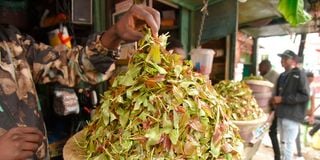
Muguka traders display their wares in Nakuru City
Individuals chewing khat have psychotic symptoms including hallucinations, delusions, and disturbed thoughts, according to a study conducted by Kenya’s renowned psychiatrist, Prof Lukoye Atwoli.
The new study undertook a large household survey to determine the association between psychotic symptoms and khat chewing in a rural khat-growing and chewing population in Kenya.
Prof Atwoli and his team of 14 experts randomly selected 831 participants aged 10 years and above residing in the Eastern region of Kenya.
“We used the psychosis screening questionnaire (PSQ) to collect information on psychotic symptoms and a researcher-designed sociodemographic and clinical questionnaire to collect information on its risk factors,” read the study.
Read: Muguka millions and Coast counties ban: The making of a regional trade dispute
In addition to its euphoric acute effect, khat users also commonly report increased levels of alertness, decreased hunger and fatigue and a general sense of well-being during chewing.
The euphoric effect is felt within an hour of chewing khat.
Cathinone which is the main alkaloid constituent of khat reaches peak plasma levels 1.5–3.5 hours after the onset of chewing.
Its average elimination half-life is four and a half hours.

Prof Lukoye Atwoli, a professor in Psychiatry.
The acute effects of euphoria and alertness are later followed by excessive feelings of anxiety and irritability, poor concentration and insomnia following chewing.
The tolerance level of khat is low and withdrawal symptoms linked to its use include nightmares, tremors, depression, sedation and hypotension.
Chronic khat use has additionally been linked to cardiovascular, digestive, genitourinary, endocrine and oral-dental health problems.
“On average 100 g of fresh khat leaves contain 36mgs of cathinone, 120 mg cathine and 8 mg norephedrine. Khat is chewed for its psychoactive effect is thought to come from two phenylalkylamines; cathinone and cathine, which are structurally related to amphetamine,” read the study.
The study revealed the prevalence of current khat chewing in the region was 36.8 per cent (306) with a male gender predominance at 54.8 per cent.
“At least one psychotic symptom was reported by 16.8 per cent (168) of the study population. Interestingly, psychotic symptoms, in general, were significantly prevalent in women at 19.5 per cent compared to men at 13.6 per cent,” read the study.
Read: ‘Muguka’ ban shines spotlight on counties’ clash over resources
Khat chewing was significantly associated with reported strange experiences including hallucinations.
“In a multivariate analysis controlling for age, gender, alcohol use and cigarette smoking, there was a positive association of strange experiences and hallucination with khat chewing. Of note was the high concurrent polysubstance use among khat chewers, specifically alcohol use (78.4 percent) and cigarette smoking (64.5 percent),” revealed the study.
The medical experts revealed that psychotic symptoms were significantly elevated in khat users in this population. Future prospective studies examining dose effect and age of first use may establish causality.
Khat, is a psychostimulant plant used by over 10 million people daily, mainly in eastern Africa and the Middle East. Historically, khat was recognised as a ceremonial plant in Kenya, chewed primarily by older men during special social gatherings.
However, the study revealed that recently, the pattern of khat consumption has been slowly changing with not only a rise in use among women and the youth but also an increase in the quantity of khat chewed.
In addition to its longstanding traditional value, the sale of khat is an important contributor to Kenya’s economy. Khat is currently Kenya’s highest-valued horticultural export accounting for about 60 per cent of the total value of such exports.
The plant is mainly cultivated in the Eastern part of Kenya. Khat is primarily ingested by chewing. The leaves and stalks of the khat plant are slowly chewed to release its juice which is then ingested with saliva.
Read: Why Mombasa has banned muguka
“The residual pulp is subsequently pushed to the side of the cheek and the mouth is continuously filled with fresh leaves. The accumulated ball of residue is eventually spat out at the end of the chewing session,” the study shows.
However, Prof Atwoli’s team said that there is divided opinion on the potency and subsequent neurobehavioral effects. Khat’s effect on the central nervous system is thought to act like amphetamine by increasing the activity of the dopaminergic and noradrenergic transmission.
“Previous studies have shown associations between heavy khat use with psychosis and mania.
In addition, some studies have pointed towards khat exacerbating or triggering primary psychotic disorders such as schizophrenia. Khat-induced psychosis has been described as transient and characterised majorly by symptoms of paranoia and mania,” stated the study.
The study stated that Khat remains a controversial plant with differing opinions on its benefits and negative impact on human health, hence as part of the Kenyan government’s efforts to understand the burden of khat use and its effects on human health, we were tasked to conduct a large, population-based study in a rural nonimmigrant population of mainly khat growers.
Read: Muguka farmers from Embu explain how Mombasa, Kilifi ban affected them
The study was conducted in Meru and Embu Counties situated in the Eastern Part of Kenya. The two counties border each other. They are the largest khat-growing region in Kenya and only second to Ethiopia in Africa.
The two communities in Embu and Meru are agrarian with a focus on cash crop cultivation. The khat variant grown in Embu is referred to as Muguka while the Meru variant is known as Miraa. The two variants are physically different with the shoots for Muguka and the leaves for Miraa being chewed.
“In Embu County, we identified two sub-counties (Mbeere North and Mbeere South) as having high production of Muguka, while in Meru, we selected four sub-counties (Igembe North, Igembe Central, Igembe South and Tigania East) for their high production of Miraa,” revealed the experts.









